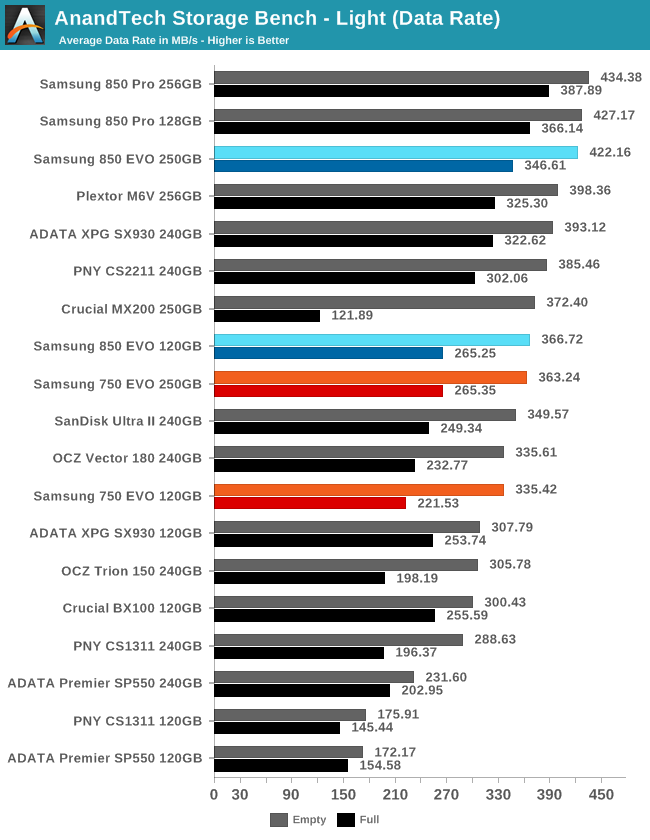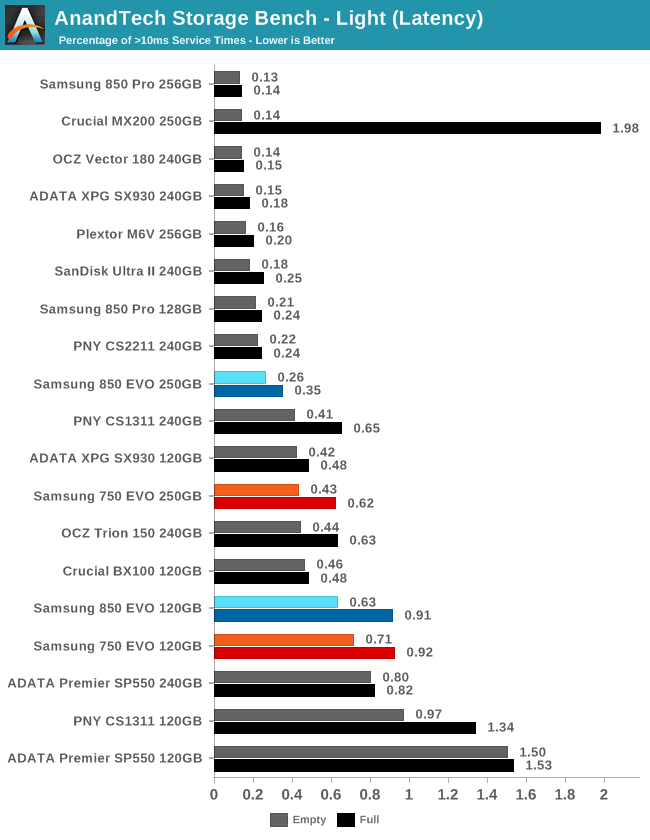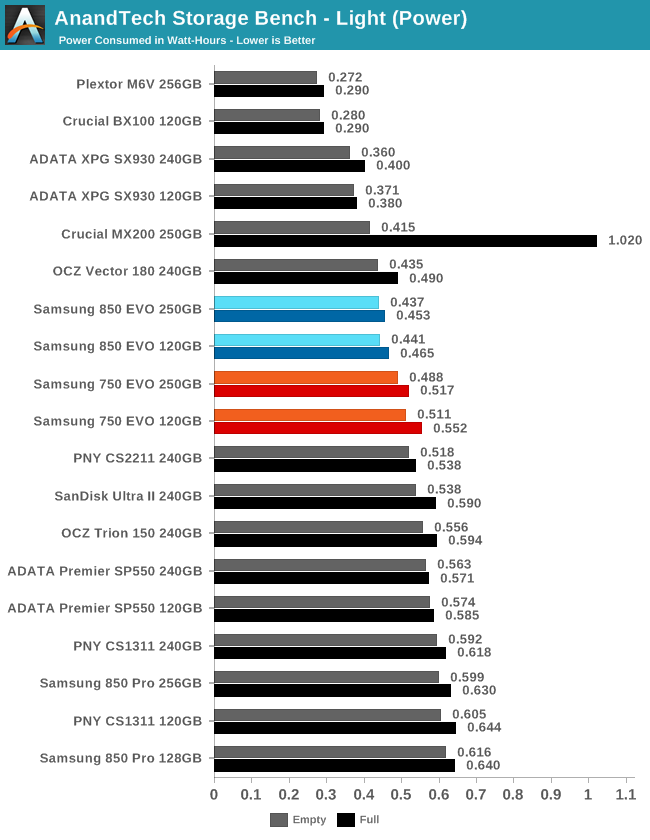The Samsung 750 EVO (120GB & 250GB) SSD Review: A Return To Planar NAND
by Billy Tallis on April 22, 2016 8:00 AM ESTAnandTech Storage Bench - Light
Our Light storage test has relatively more sequential accesses and lower queue depths than The Destroyer or the Heavy test, and it's by far the shortest test overall. It's based largely on applications that aren't highly dependent on storage performance, so this is a test more of application launch times and file load times. This test can be seen as the sum of all the little delays in daily usage, but with the idle times trimmed to 25ms it takes less than half an hour to run. Details of the Light test can be found here.

The average data rate scores of the 750 EVOs allow it to blend in to the crowd as a solid performer and the fastest planar TLC drive on the Light test.

The average service time of the 750 EVO again places it as one of the fastest planar TLC drives and a reasonable performer compared to the SATA market overall. The 120GB 750 EVO is also relatively close to the 250GB version, while other 120GB models are considerably slower than their larger counterparts.

The number of latency outliers experienced by the 750 EVO in the Light test is normal for TLC drives but considerably higher than most MLC drives.

Power usage over the course of the Light test separates the drives pretty cleanly into different categories. The 750 EVO clearly requires more power than the 850 EVO, and all the other TLC drives require more power than the 750 EVO. The MLC drives all require less energy than all the TLC drives, except that the 850 Pro sacrifices efficiency to deliver its high performance.










109 Comments
View All Comments
Ascaris - Thursday, April 28, 2016 - link
Isn't that the truth! Nearly every item comes with glowing reviews mixed in with "mine died in xx time, and I am never going to buy from $company ever again." Consumer routers and hard drives seem particularly bad in that way-- if I avoided all of the ones with horror stories, I'd never have either of them.Another thing people tend to overlook in reliability is the role of a good power supply. A cheap PSU can slowly sap the life from all the components in the system by introducing unacceptable levels of ripple, and you'd never know that was a cause or partial cause of the failure. On a laptop with the brick-style power supply, it is a good idea to replace a failed unit with an OEM unit of recent manufacture (less chance of dried-up caps) than some eBay special of unknown origin (other than to say China, which is where the OEM one came from too, almost certainly).
For desktops, the PSU is something people sometimes skimp on. I've never actually had a prebuilt desktop, but I would bet a lot of them have cheap PSUs, as it is probably a place where pennies can be pinched without a huge increase in RMAs before the warranty expires. I looked at new PCs on the site of one of the major online sellers about a year ago, and I was surprised at how many current models still had 120/240v switches on the PSU, which shows that they are older models without active PFC. That does not necessarily mean they're of poor quality, but it does make me wonder about them.
BrokenCrayons - Friday, April 22, 2016 - link
I think it needs to come down in price before it'll be an acceptable sort of purchase.zepi - Friday, April 22, 2016 - link
SSD's have lost a lot by being so hamstrung by their interfaces. CPU's have limited number of PCI-e connections and motherboards very little space for M.2 slots. SATA 3 is slow and bad protocol for SSD so that race to the bottom is only thing that is of any interest in 2.5" drives.TheinsanegamerN - Friday, April 22, 2016 - link
SATA 3 may not be super fast, but the only observable difference, IME, between an m.2 drive and a sata drive was 2 seconds on boot. Unless you are a content creator working with laarge video/pictures, m.2 has little to offer over sata.Especially given that 2TB sata ssds exist, while m.2 is limited to 512GB, and that 512GB m.2 is more expensive than a 1TB sata ssd. And the ehat that m.2 drives give off compared to sata.
Margalus - Friday, April 22, 2016 - link
It may be "cheap", but it's worthless in my opinion. Only 120GB or 250GB, pretty much too small for anything except a boot drive. If there are no 1TB drives, why bother?TheinsanegamerN - Friday, April 22, 2016 - link
Believe it or not, many people could fit their computer needs in 250GB.I only use about 500GB between all of the games I actually play, and the OS itself.
Meteor2 - Friday, April 22, 2016 - link
Mmmm, I think a lot of people have digital media collections now. I have no DVDs or Blu Rays, but 600 GB of films and TV series.barleyguy - Friday, April 22, 2016 - link
Video doesn't need SSD levels of performance. Any modern spinning disk is fast enough to play video, even up to 4K.Personally, my video server machine is a 250 GB MX200 M-SATA SSD and a 4 TB hard drive.
Meteor2 - Saturday, April 23, 2016 - link
Absolutely but I want a single high-performance disc.Bleakwise - Sunday, April 24, 2016 - link
Why do you want an SSD for cold storage backups? That's just silly.